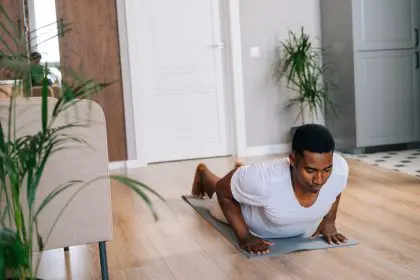Feeling like you’re running on fumes lately? You’re not alone. Between the endless Zoom calls, family responsibilities, and that Netflix show you just can’t stop watching at 1 AM, energy has become our most precious and depleted resource. But what if the solution isn’t another espresso shot or energy drink? What if it’s actually moving your body in specific ways that science has found particularly effective for boosting energy levels?
Let me guess – when you’re tired, the last thing you want to do is exercise. It seems counterintuitive, right? “I’m exhausted, so let me go exhaust myself more.” But here’s the fascinating thing about our bodies – sometimes they operate on opposite day rules.
The energy paradox explained
Your body isn’t a smartphone with a steadily decreasing battery percentage throughout the day. It’s more like a self-charging system that sometimes needs a jumpstart. When you’re feeling drained, certain types of movement can actually create more energy than they consume.
The secret lies in how exercise affects everything from your cellular powerhouses to your brain chemistry. When you move in the right ways, you’re not just burning calories – you’re triggering a cascade of biological processes that can leave you feeling more energized than when you started.
Think of it like priming an old-fashioned water pump. You have to put in a little water first to get the flow started, but then you get back way more than you put in.
The energizing workout blueprint
Not all workouts are created equal when it comes to boosting your energy. Some training styles might leave you drained for hours, while others can give you an immediate lift. Here’s the ideal approach for when you need to power up, not wind down:
Start with dynamic stretching, not static
Forget holding those toe touches for 30 seconds. When energy is your goal, you want movement-based stretching that gradually increases your range of motion while getting your blood flowing. Try arm circles that get progressively larger, walking lunges, gentle torso twists, and leg swings.
This gentle movement helps increase blood flow without shocking your system, making it the perfect on-ramp to more vigorous activity.
The magic 20-minute cardio sweet spot
When it comes to energy-boosting cardio, timing matters more than you might think. Aim for approximately 20 minutes of moderate-intensity cardio – this hits the sweet spot where you’ll get the energizing benefits without tipping over into fatigue.
What counts as moderate? You should be breathing heavier than normal but still able to hold a conversation. If you can sing, pick up the pace. If you can’t speak at all, dial it back.
Great options include brisk walking, especially outdoors or on an incline, light jogging, elliptical training, cycling, or dancing to your favorite high-energy playlist. The key is consistency in your effort level – avoid intense bursts that might drain your reserves.
Strength training with a twist
Traditional heavyweight, low-rep strength training is great for building muscle, but it’s not ideal for an immediate energy boost. Instead, try a circuit of bodyweight exercises with minimal rest between movements.
A simple but effective circuit might include:
- 10-15 squats
- 10 modified push-ups
- 30-second plank
- 10 lunges each leg
- 10-15 glute bridges
The goal is to move continuously through the circuit 2-3 times with just enough resistance to feel the work but not so much that you’re straining. This approach stimulates your muscles and cardiovascular system without overtaxing them.
The yoga energy connection
Certain yoga poses are particularly effective for fighting fatigue. Poses that open the chest and incorporate mild backbends can be especially energizing, as they counteract the hunched posture many of us adopt at desks all day.
Try a sequence of cat-cow stretches, cobra pose, and downward dog, focusing on linking your movement with deep, intentional breathing. Even 5 minutes of these poses can help reset your energy meter.
Timing is everything
The when matters almost as much as the what. While many people swear by morning workouts for all-day energy, the truth is more nuanced.
If you’re a natural early bird, morning exercise can indeed set you up for an energized day. But if dragging yourself out of bed feels like torture, a midday workout might serve you better. That 2-3 PM slump when your eyelids feel like they’re made of concrete? That’s actually an ideal time to step away for a quick movement session.
What about evening workouts? While conventional wisdom warns against exercising too close to bedtime, moderate activity 2-3 hours before sleep can actually help some people wind down more effectively later.
The real key is consistency. Your body thrives on routine, so try to work out at similar times each day to maximize the energizing effects.
The post-workout energy boost
What you do immediately after your workout can either extend your energy boost or cut it short. Skip the sugary sports drinks and heavy meals that might lead to a crash. Instead, rehydrate with plain water and have a small snack combining protein and complex carbs within 30 minutes.
A banana with a tablespoon of nut butter, Greek yogurt with berries, or a small handful of trail mix can help stabilize your blood sugar and extend that post-workout high.
Don’t underestimate the power of a quick cool-down, either. Two to three minutes of gentle movement and deeper breathing helps your body transition out of exercise mode while preserving that energized feeling.
Getting started when you’re running on empty
Let’s be real – when you’re truly exhausted, even the most perfectly designed workout can seem impossible to start. The trick is to commit to just five minutes. Tell yourself you can stop after that if you still feel terrible.
More often than not, those five minutes will generate enough momentum and initial energy to carry you through the full session. And if not? Even that small amount of movement is better than nothing.
Remember, the goal isn’t to crush yourself with intensity. It’s to move just enough to tap into your body’s natural energy production systems. Listen to what your body tells you and adjust accordingly.
The most energizing workout ultimately isn’t about specific exercises – it’s about finding sustainable movement that you’ll actually do consistently. Because even the perfect energy-boosting routine won’t help if it stays in the realm of good intentions rather than regular practice.
So what are you waiting for? Your energy renaissance might be just one workout away.














